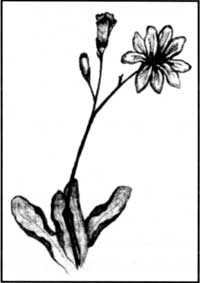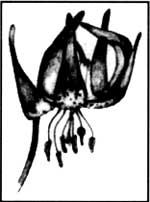An avenue for plant migration
 Imperial Lewisia. Drawing by Heather McDonald. |
The KSE is unusual in that it has more serpentine than any other ecoregion. The serpentine masses and size of the KSE helps plant migrants find suitable habitats more easily but are big enough to keep extinction rates low. Serpentine in the Illinois Valley, for example, is fragmented and possesses different chemistries—an ideal situation for rapidly evolving small populations. The effects of fire or other disturbances may be so long lasting that plant populations are separated sufficiently and can evolve into new species. By the same token, disturbances in the KSE are not so large and competition among plants is not intense enough for extinction rates to increase. Varied rainfall amounts, frequent burns, and areas that serve as barriers (riparian zones, serpentine, cliffs, north slopes) tend to limit fires to patches of moderate size and intensity. Consequently, no one successional stage dominates with its restricted number of species.
Another reason for the relatively high species diversity in the KSE is because it contains the only mountains linking coastal ranges in California and Oregon with the Cascade-Sierra cordillera. Plants more easily cross over east-west oriented mountains, unlike north-south ranges where plants must migrate along lines of longitude if they cannot cross high elevations. Migration can promote speciation because it produces numerous small and isolated populations near the range limit of a species, a situation common in the KSE. Proximity to the endemic-rich Cascades, Sierra, and the coast ranges of northern California has increased plant diversity as the KSE shares over 200 endemics with these physiographic regions. At least half of those plants probably originated in the KSE.
 Vollmers Tiger Lilly. Drawing by Heather McDonald. |
Extinction is low among shrubs and trees generally, furnishing an important reason why they comprise many of the paleoendemics, or “living fossils.” If you live a long time, you have more chance of reproducing at least once successfully. Even serpentine herbs tend to be long-lived, a trait indicative of harsh environments, and one the likely increases the number of endemics. During the great climate changes over the last few million years, the closely packed habitats of the KSE allowed plants to grow in adjacent habitats that increased the chances for survival when the climatic regimes shifted. Some habitats shrank considerably, but paleoendemics in them continued to thrive. Port Orford-cedar and Brewer (or weeping) spruce are examples of paleoendemics that once had more extensive ranges.
Another type of endemic commonly found in the KSE is the edaphic endemic or geoendemics—those species mostly restricted to one soil type or topographic situation. Neoendemics (plants with no nearby relatives) in the KSE also appear to be more common near the north end of their range at high elevations, perhaps because they are also glacial relicts that found suitable cool and open habitats to colonize. Among the endemic plants in the KSE, 80 types are found only on serpentine, while seven are confined to granite, four on marble, and three on volcanic rock.

